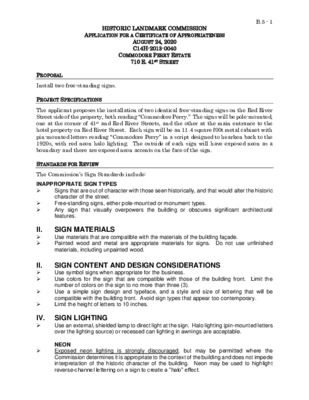B.5 - Commodore Perry Hotel signs — original pdf
Backup

HISTORIC LANDMARK COMMISSION APPLICATION FOR A CERTIFICATE OF APPROPRIATENESS B.5 - 1 AUGUST 24, 2020 C14H-2013-0040 COMMODORE PERRY ESTATE 710 E. 41ST STREET PROPOSAL Install two free-standing signs. PROJECT SPECIFICATIONS The applicant proposes the installation of two identical free-standing signs on the Red River Street side of the property, both reading “Commodore Perry.” The signs will be pole-mounted, one at the corner of 41st and Red River Streets, and the other at the main entrance to the hotel property on Red River Street. Each sign will be an 11.4 square f00t metal cabinet with pin-mounted letters reading “Commodore Perry” in a script designed to hearken back to the 1920s, with red neon halo lighting. The outside of each sign will have exposed neon as a boundary and there are exposed neon accents on the face of the sign. STANDARDS FOR REVIEW The Commission’s Sign Standards include: INAPPROPRIATE SIGN TYPES ➢ Signs that are out of character with those seen historically, and that would alter the historic character of the street. Free-standing signs, either pole-mounted or monument types. Any sign that visually overpowers the building or obscures significant architectural features. SIGN MATERIALS Use materials that are compatible with the materials of the building façade. Painted wood and metal are appropriate materials for signs. Do not use unfinished materials, including unpainted wood. SIGN CONTENT AND DESIGN CONSIDERATIONS Use symbol signs when appropriate for the business. Use colors for the sign that are compatible with those of the building front. Limit the number of colors on the sign to no more than three (3). Use a simple sign design and typeface, and a style and size of lettering that will be compatible with the building front. Avoid sign types that appear too contemporary. Limit the height of letters to 10 inches. Use an external, shielded lamp to direct light at the sign. Halo lighting (pin-mounted letters over the lighting source) or recessed can lighting in awnings are acceptable. NEON Exposed neon lighting is strongly discouraged, but may be permitted where the Commission determines it is appropriate to the context of the building and does not impede interpretation of the historic character of the building. Neon may be used to highlight reverse-channel lettering on a sign to create a “halo” effect. ➢ IV. SIGN LIGHTING ➢ ➢ ➢ II. ➢ ➢ II. ➢ ➢ ➢ ➢ B.5 - 2 Applications for signs with exposed neon lighting must show through photographic documentation that the building had a sign with exposed neon in the historic period. ➢ COMMITTEE RECOMMENDATIONS Not reviewed. STAFF RECOMMENDATION Approve as proposed. Although the standards prohibit pole signs such as these, the standards are focused on downtown historic buildings, particularly along 6th Street, and staff believes they qualify as an exception to the general prohibition. The signs are an appropriate size for their environment and feature the letters and details encouraged by the sign standards. The lettering on the sign is halo-lit and while there is no precedent for neon at this location, as the property was previously a private residence and a school, there is no history of a commercial use requiring signage at this location. Staff suggests that the use of neon on these signs can be approved as appropriate given the type of business, the location of the property on a busy street, and therefore the increased visibility that neon accents will bring to the sign. The Commission has approved a similar sign at the Hotel Saint Cecelia on Academy Drive in South Austin, another historic landmark. B.5 - 3 B.5 - 4 B.5 - 5 Approved sign at the Hotel Saint Cecilia on Academy Drive at a landmark property.